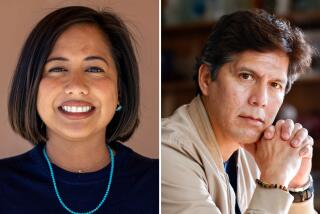LOCAL ELECTIONS ESCONDIDO CITY COUNCIL : First Elected Mayor to Lead City Amid Continuing Growth Battle
- Share via
Escondido voters will get their first chance to pick their city’s mayor Tuesday. And the two candidates present a clear-cut choice because they stand at opposite ends of the spectrum in their views on growth.
Voters rewrote the council script in 1988, electing three slow-growth candidates in a landslide, replacing a long-entrenched pro-growth majority on the council, and opting for a directly elected mayor.
After a long reign by business and banking interests, the Escondido City Council has shifted into reverse for the past two years as the new slow-growth majority whittled down developers’ plans and reversed expansionist city policies.
On Tuesday, two veteran council adversaries--Jerry Harmon and Doug Best--will vie for the honor of becoming Escondido’s first elected mayor, and incumbent councilman Ernie Cowan will face stiff opposition from two slow-growth candidates: planning commission chairwoman June Rady and elementary school board trustee Sid Hollins.
Harmon, who was one of three slow-growth candidates swept to victory in the June, 1988, elections, appears to be a shoo-in to become mayor over Best, who was one of the 13 also-rans in that race. Two years ago, Best made a poor showing in the council race even though he was the incumbent.
Best, however, considers his chances “very good to excellent” to beat Harmon, now in his fifth council term, despite Harmon’s runaway victory in 1988.
“People have had a taste of the slow-growth troika and of their fiscal irresponsibility in the last two years,” Best said. He thinks the tide has turned and Escondido voters want a more conservative council. The slow-growthers’ goals for improvements to public services and the quality of life are too costly for the city to implement, Best said.
Best, 64 and a 12-year council veteran, has clashed with Harmon, 46, repeatedly over the years, chiefly on growth issues. Best was a planning commissioner in 1972 when the commission formulated a general plan that called for the city to grow to a population of nearly 300,000--three times its present size.
Since 1988, Harmon has led the council’s slow-growth majority in a successful effort to halve development densities in the city by revamping the general plan to produce an eventual city population of about 150,000 residents.
Best concedes that, even if he and like-thinking Cowan are elected Tuesday, the slow-growth trio of Harmon, Kris Murphy and Carla DeDominicis will still hold the voting edge on the council because Harmon will retain his present council seat, even if he loses the mayoral race to Best.
And, if Harmon wins the mayor’s post, his council seat probably will be filled by council appointment, with the slow-growth majority picking the new member.
Best is campaigning hard on the point that the slow-growth majority is leading the city into stormy fiscal seas. He predicts “catastrophic new financial losses” as a result of lawsuits filed against the city by developers caught in the city’s new policies, which require new development to pay for itself by providing the public amenities that its future occupants will need through assessments and development fees.
Harmon admits that business and financial interests are opposed to the new city plan, but “I’m convinced, based on the results of the last election, that the people of Escondido are behind us” in reining back the city’s growth rate to a more leisurely pace.
Cowan faces a similar problem in campaigning to retain his seat on the council as Best does in the mayoral race. His opponents accuse him of being a pawn of pro-growth interests and in the pocket of developers.
A recent campaign filing by a developer of the Daley Ranch--a proposed 3,000-acre residential community that will be the single largest development in the North County city--showed that Shea Homes had spent about $24,000 to conduct a campaign in behalf of Cowan.
“That sure didn’t help me,” Cowan said.
He said he was not aware of the Shea campaign until last week and immediately tried to halt the developer’s campaign efforts, without success.
Cowan, a councilman since 1982, said that he is not opposed to many of the goals of the slow-growth council majority but feels that they are seeking to do too much too quickly without considering the costs.
The high standards of city services spelled out in the new general plan “can’t be delivered without steep increases in city fees and taxes, which I oppose,” Cowan said. “I believe in living within the budget.”
June Rady, who came in sixth out of 15 candidates in the 1988 councilmanic elections, considers herself to be a middle-of-the-road candidate, who supports the new general plan, “but I feel that there should be some flexibility there, so that we as a city can be responsive to the economic climate.”
“I believe that we are in a recession right now,” she said, “and I want the people to know that I am aware of the realities, of the economics of this plan. We must adjust to the economic situation, not go overboard.”
Hollins, 62, is a retired elementary school administrator who headed a citizens committee that revamped the city’s general plan to reflect the slow-growth philosophy of the council majority.
Hollins hopes to improve relations between the school districts and the city government, a relationship that has been less than friendly because of a sharp difference of opinion over the division of tax revenues flowing into the city redevelopment agency. The schools want money for building schools; the city has already committed future revenues to civic and cultural projects.
More to Read
Sign up for Essential California
The most important California stories and recommendations in your inbox every morning.
You may occasionally receive promotional content from the Los Angeles Times.










